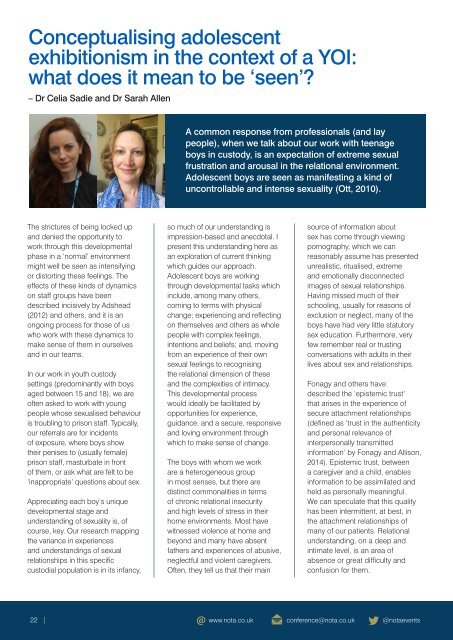NOTA News Newsletter July 2018 1
Create successful ePaper yourself
Turn your PDF publications into a flip-book with our unique Google optimized e-Paper software.
Conceptualising adolescent<br />
exhibitionism in the context of a YOI:<br />
what does it mean to be ‘seen’?<br />
– Dr Celia Sadie and Dr Sarah Allen<br />
A common response from professionals (and lay<br />
people), when we talk about our work with teenage<br />
boys in custody, is an expectation of extreme sexual<br />
frustration and arousal in the relational environment.<br />
Adolescent boys are seen as manifesting a kind of<br />
uncontrollable and intense sexuality (Ott, 2010).<br />
The strictures of being locked up<br />
and denied the opportunity to<br />
work through this developmental<br />
phase in a ‘normal’ environment<br />
might well be seen as intensifying<br />
or distorting these feelings. The<br />
effects of these kinds of dynamics<br />
on staff groups have been<br />
described incisively by Adshead<br />
(2012) and others, and it is an<br />
ongoing process for those of us<br />
who work with these dynamics to<br />
make sense of them in ourselves<br />
and in our teams.<br />
In our work in youth custody<br />
settings (predominantly with boys<br />
aged between 15 and 18), we are<br />
often asked to work with young<br />
people whose sexualised behaviour<br />
is troubling to prison staff. Typically,<br />
our referrals are for incidents<br />
of exposure, where boys show<br />
their penises to (usually female)<br />
prison staff, masturbate in front<br />
of them, or ask what are felt to be<br />
‘inappropriate’ questions about sex.<br />
Appreciating each boy’s unique<br />
developmental stage and<br />
understanding of sexuality is, of<br />
course, key. Our research mapping<br />
the variance in experiences<br />
and understandings of sexual<br />
relationships in this specific<br />
custodial population is in its infancy,<br />
so much of our understanding is<br />
impression-based and anecdotal. I<br />
present this understanding here as<br />
an exploration of current thinking<br />
which guides our approach.<br />
Adolescent boys are working<br />
through developmental tasks which<br />
include, among many others,<br />
coming to terms with physical<br />
change; experiencing and reflecting<br />
on themselves and others as whole<br />
people with complex feelings,<br />
intentions and beliefs; and, moving<br />
from an experience of their own<br />
sexual feelings to recognising<br />
the relational dimension of these<br />
and the complexities of intimacy.<br />
This developmental process<br />
would ideally be facilitated by<br />
opportunities for experience,<br />
guidance, and a secure, responsive<br />
and loving environment through<br />
which to make sense of change.<br />
The boys with whom we work<br />
are a heterogeneous group<br />
in most senses, but there are<br />
distinct commonalities in terms<br />
of chronic relational insecurity<br />
and high levels of stress in their<br />
home environments. Most have<br />
witnessed violence at home and<br />
beyond and many have absent<br />
fathers and experiences of abusive,<br />
neglectful and violent caregivers.<br />
Often, they tell us that their main<br />
source of information about<br />
sex has come through viewing<br />
pornography, which we can<br />
reasonably assume has presented<br />
unrealistic, ritualised, extreme<br />
and emotionally disconnected<br />
images of sexual relationships.<br />
Having missed much of their<br />
schooling, usually for reasons of<br />
exclusion or neglect, many of the<br />
boys have had very little statutory<br />
sex education. Furthermore, very<br />
few remember real or trusting<br />
conversations with adults in their<br />
lives about sex and relationships.<br />
Fonagy and others have<br />
described the ‘epistemic trust’<br />
that arises in the experience of<br />
secure attachment relationships<br />
(defined as ‘trust in the authenticity<br />
and personal relevance of<br />
interpersonally transmitted<br />
information’ by Fonagy and Allison,<br />
2014). Epistemic trust, between<br />
a caregiver and a child, enables<br />
information to be assimilated and<br />
held as personally meaningful.<br />
We can speculate that this quality<br />
has been intermittent, at best, in<br />
the attachment relationships of<br />
many of our patients. Relational<br />
understanding, on a deep and<br />
intimate level, is an area of<br />
absence or great difficulty and<br />
confusion for them.<br />
22 | www.nota.co.uk conference@nota.co.uk @notaevents





